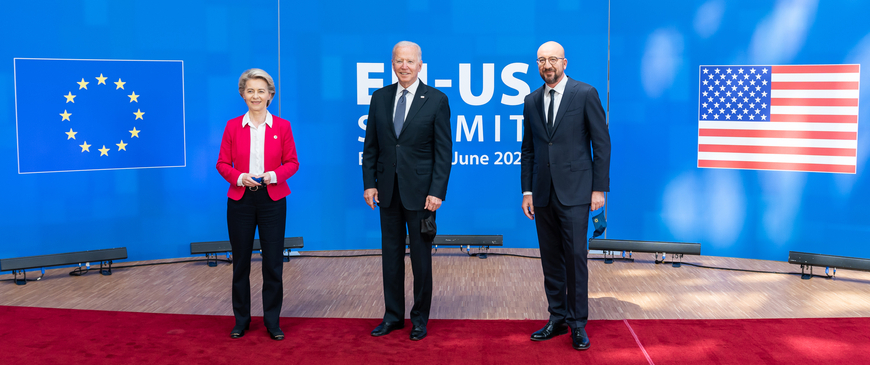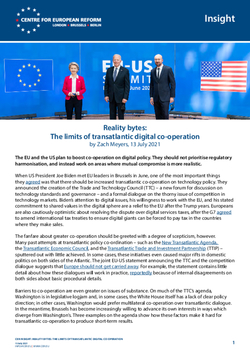
Reality bytes: The limits of transatlantic digital co-operation
The EU and the US plan to boost co-operation on digital policy. They should not prioritise regulatory harmonisation, and instead work on areas where mutual compromise is more realistic.
When US President Joe Biden met EU leaders in Brussels in June, one of the most important things they agreed was that there should be increased transatlantic co-operation on technology policy. They announced the creation of the Trade and Technology Council (TTC) – a new forum for discussion on technology standards and governance – and a formal dialogue on the thorny issue of competition in technology markets. Biden’s attention to digital issues, his willingness to work with the EU, and his stated commitment to shared values in the digital sphere are a relief to the EU after the Trump years. Europeans are also cautiously optimistic about resolving the dispute over digital services taxes, after the G7 agreed to amend international tax treaties to ensure digital giants can be forced to pay tax in the countries where they make sales.
The fanfare about greater co-operation should be greeted with a degree of scepticism, however. Many past attempts at transatlantic policy co-ordination – such as the New Transatlantic Agenda, the Transatlantic Economic Council, and the Transatlantic Trade and Investment Partnership (TTIP) – sputtered out with little achieved. In some cases, these initiatives even caused major rifts in domestic politics on both sides of the Atlantic. The joint EU-US statement announcing the TTC and the competition dialogue suggests that Europe should not get carried away. For example, the statement contains little detail about how these dialogues will work in practice, reportedly because of internal disagreements on both sides about basic procedural details.
The joint EU-US statement announcing the TTC and the competition dialogue suggests that Europe should not get carried away.
Barriers to co-operation are even greater on issues of substance. On much of the TTC’s agenda, Washington is in legislative logjam and, in some cases, the White House itself has a lack of clear policy direction; in other cases, Washington would prefer multilateral co-operation over transatlantic dialogue. In the meantime, Brussels has become increasingly willing to advance its own interests in ways which diverge from Washington’s. Three examples on the agenda show how these factors make it hard for transatlantic co-operation to produce short-term results.
- First, the EU has moved more decisively than the US to address the competition issues raised by large, mostly American, digital platforms. The European Parliament is currently considering the Digital Markets Act (DMA) which will require that big platforms change the way they treat business and consumers – effectively altering their current business model altogether.
The Biden administration has empowered US antitrust agencies to tackle big tech at home. But the administration lacks any clear policy on whether existing antitrust law needs to be supplemented with new regulations like the DMA for online platforms generally. Biden’s recently announced executive order on promoting competition addressed the technology sector. It focused, however, on merger control and data privacy, only pointing to the potential for rules similar to the DMA in the specific context of online marketplaces, rather than for all online platforms. While some US legislative proposals are more similar to the DMA, their passage is far from assured, with many Democrats concerned to protect Silicon Valley and many Republicans focused solely on big tech’s content moderation practices. In the meantime, the Biden administration appears to be mostly concerned that the DMA should not discriminate against American firms. This is probably why the joint EU-US statement does not make any reference to how Europe and the US should deal with harmful market behaviour by big tech, other than vaguely referring to “co-operation in the tech sector”. This silence was even more surprising after the US signed up to far clearer language in the G7 communiqué just days before. The communiqué recognises that there is an “international consensus that participants with significant market power can exploit their power to hold back digital markets”. The European Commission, on its part, confidently asserted recently that big tech’s “harmful market behaviours” were a shared EU and US concern.
The Biden administration’s concerns about discrimination reignited immediately after the EU-US statement. German MEP Andreas Schwab, who is shepherding the DMA through the European Parliament, wants to narrow the DMA’s scope from 10-20 firms – which would include at least one European firm – to a handful of firms that would probably all be American. The US National Security Council was infuriated and, in a leaked email to the EU’s delegation to Washington, complained that the plan would “hinder our ability to work together”. Schwab’s proposal was reasonable: the DMA would still use objective criteria to determine which platforms will be regulated, and under any reasonable measure, American platforms have the most significant market power. However, for now, Biden still seems defensive of America’s tech champions abroad. Co-operation on digital competition will remain difficult while Washington views the DMA as an unjustified threat to the competitiveness of US firms.
Brussels has become increasingly willing to advance its own technology interests in ways which diverge from Washington’s.
- Second, tension between the EU and US approaches to artificial intelligence (AI) is increasingly obvious. The EU-US statement barely talked about AI: in particular, it neglected the EU’s stated intention to start work on a “transatlantic AI agreement”. This reflects concern within parts of the US administration that the European Commission published a proposal to regulate artificial intelligence in Europe just weeks before the EU-US summit. The EU proposal provides an overarching regulatory framework for AI innovation. This does not align with America’s desire not to constrain AI innovation – an approach which has led the US to focus instead on voluntary standards, guidelines and principles rather than binding rules; and to applying existing laws such as consumer protection standards to AI rather than imposing bespoke restrictions.
That proposal prompted the Chair of the US National Security Commission on AI to accuse the EU of failing to be “an innovation partner to the US”. Just as with digital competition issues, the G7 communiqué days before the EU-US summit covered AI in considerably more detail. This suggests that the US now prefers co-operation on AI to take place through multilateral forums, such as the OECD, which can be steered away from the EU’s approach. There is still some scope for bilateral co-operation on AI within the framework of the Commission’s proposal but, probably, not much. - Third, the US has been disappointed by the lack of progress in restoring the flow of personal data from the EU to America, after the European Court of Justice ruled last year that the US legal system failed to provide sufficient protection for Europeans. The legality of companies transferring personal data from the EU to the US became uncertain. Biden reportedly wanted his visit to produce a political solution to this problem, but the EU and the US failed to agree. That failure was unsurprising: to comply with Europe’s General Data Protection Regulation (GDPR), the US needs to impose binding legal constraints on its data surveillance activities, not just provide political or ‘soft law’ assurances. Contrary to popular thinking, the US has made significant efforts – such as the Judicial Redress Act of 2015 – to try to conform transatlantic data transfers with the GDPR. However, it is politically difficult for the US to curtail its national security programs merely to conform with EU privacy demands. Any solution will probably emerge only from nascent domestic proposals for a federal privacy law and, even then, only if the law ultimately provides the level of protection the GDPR requires for cross-border transfers.
Rather than trying to solve these issues, which are likely to be intractable in the short term, the EU-US digital dialogue should instead focus on issues where there is some convergence between EU and US objectives and where different approaches to achieving them are not yet entrenched. One example is how to respond to China. The need to maintain the US’s technological lead over China is an area of rare bipartisan agreement in Washington: the US Senate recently passed a bill to allocate €210 billion to support US semiconductor production, quantum computing and AI – all areas where the US fears China is obtaining a competitive edge. The EU, while more eager than the US to maintain its economic relationship with China, increasingly shares America’s concerns. For example, at Washington’s urging, many EU member-states have gradually excluded Chinese equipment from fibre-based and 5G telecommunications networks, or limited its use. The EU is also tackling China’s foreign subsidies, inward investment, and its lack of a level playing field in public procurement, and the European Parliament has put on hold ratification of a proposed EU-China investment agreement. Growing EU and US convergence on China was reflected in the joint EU-US statement: the US adopted the EU’s oft-cited description of relations with China as having “elements of co-operation, competition, and systemic rivalry”.
EU-US digital dialogue should focus on issues where there is convergence between EU and US objectives and where different approaches to achieving them are not yet entrenched.
The EU-US dialogue should prioritise the risks posed by China to digital supply chain resilience. Semiconductors are the most cited example. The EU and US both regret their long-term decline in semiconductor manufacturing, which has now become concentrated in east Asia, as Chart 1 shows. A single Taiwanese company, TSMC, is responsible for more than half of global semiconductor production revenues thanks to its lead in the production of almost all cutting-edge chips. Meanwhile, China’s semiconductor manufacturing capacity is growing rapidly.
![]()
The EU and US want to repatriate more chip manufacturing, to reduce reliance on east Asia. The Commission wants the EU to produce at least 20 per cent of the world’s chips by 2030, but it is unclear how the bloc will achieve such an ambitious target. Only a few member-states have committed significant funding to back up these plans: for example, Germany will devote €1.5 billion in recovery funds, and Austria €125 million, to the semiconductor industry. The US, meanwhile, has passed legislation committing approximately €45 billion to support domestic manufacturing. Both the EU and US figures pale, however, in comparison to the €126 billion China plans to spend to boost its own indigenous chip design and manufacturing capabilities.
The EU and the US should not compete against each other to attract manufacturing investment. That would probably drive up costs for both, and would deliver manufacturing capacity that Europe does not need. However, co-operation in related areas would produce greater mutual benefit. Washington and Brussels should work together to assist existing European and American semiconductor manufacturers to identify the most risky chokepoints in their supply chains, and address those chokepoints in cases where the manufacturers cannot effectively do so themselves. While supply chains remain reliant on Chinese rare earths, for example, the EU and US should use trade policy to promote access to new sources of rare earths in other parts of the world and fund joint research into greener ways to extract or recycle them or into finding alternatives.
The EU and the US must accept that digital co-operation will be easier in some areas than others. Their short-term focus should remain on policy areas where their interests are aligned and jointly agreed solutions are politically realistic. Brussels and Washington should avoid prioritising issues – such as regulatory harmonisation – that are likely to require a fundamental change in the views of one side. Otherwise, the TTC and the competition dialogue will probably suffer the same slow slide into obscurity as past attempts at transatlantic technology dialogues.
Zach Meyers is a research fellow at the Centre for European Reform.


Add new comment